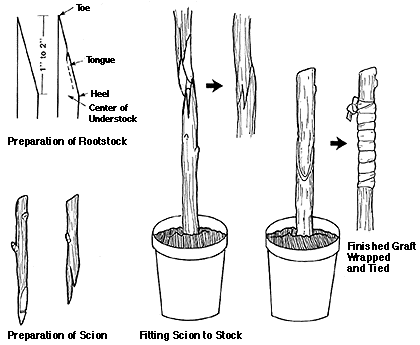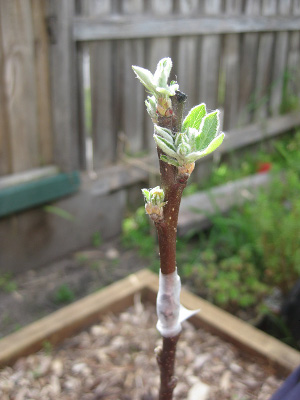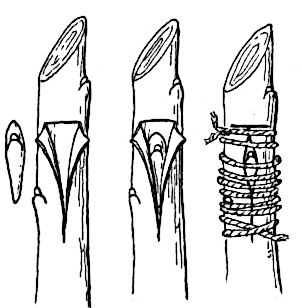
Two grafts for beginners
 When it comes right down to
it, you really only need to know two methods to graft most young fruit
trees. The whip and tongue graft is the simplest, appropriate for
young apple and pear trees grafted onto rootstock the same
pencil-thickness as the scionwood. Budding is used if you have
very little scionwood to go arond or if you need to graft a cherry,
plum, apricot, or peach, none of which are reputed to respond well to
whip and tongue grafting. Budding is also less sensitive to the
scionwood and rootstock having different diameters.
When it comes right down to
it, you really only need to know two methods to graft most young fruit
trees. The whip and tongue graft is the simplest, appropriate for
young apple and pear trees grafted onto rootstock the same
pencil-thickness as the scionwood. Budding is used if you have
very little scionwood to go arond or if you need to graft a cherry,
plum, apricot, or peach, none of which are reputed to respond well to
whip and tongue grafting. Budding is also less sensitive to the
scionwood and rootstock having different diameters.
A whip and tongue graft
joins the scionwood to the top of the rootstock using a slanting cut to
increase surface area and a notch (the tongue) to help the two pieces
stay in place as you tie them. Select a point about four to eight
inches above the ground on the rootstock, where the diameters of the
two pieces of wood match, then make a cut six times the diameter of the
wood (says Garner), or roughly an inch and a
half long (says Phillips). You'll want to
practice until you can make a cut with no bulges or raggedness, then
focus on lining up the tips and the cambium all around so that there's
an 80% visual match. Add the tongue (a 1/8 inch cut into each
piece of wood), then trim the scion to two buds before slipping the
joints together.
 After making the cuts for a
whip and tongue graft, you'll want to wrap the new tree with some kind
of binding
material to hold the junction firmly in place. Start at the
bottom and leave space between loops as you circle up to ensure you
haven't gotten the pieces out of alignment, then cover everything up by
taping back down over the junction. Add some sealant on the tip
and over the tape and then plant your new tree out in a garden bed for
the first year. In early June, the buds on the scionwood should
have sprouted and the longest should be at least two to four inches
long; that's your cue to pinch the tips of all but the best shoot and
to remove any rootstock growth.
After making the cuts for a
whip and tongue graft, you'll want to wrap the new tree with some kind
of binding
material to hold the junction firmly in place. Start at the
bottom and leave space between loops as you circle up to ensure you
haven't gotten the pieces out of alignment, then cover everything up by
taping back down over the junction. Add some sealant on the tip
and over the tape and then plant your new tree out in a garden bed for
the first year. In early June, the buds on the scionwood should
have sprouted and the longest should be at least two to four inches
long; that's your cue to pinch the tips of all but the best shoot and
to remove any rootstock growth.
These instructions
assume you're followed the American trend of bench grafting (which
simply means you dug up rootstocks and took them inside to graft), in
which case you probably joined your rootstock and scionwood between
December and March. If grafting onto a rootstock in the field,
you'll want to wait until the week before the first green shows on the
buds so that winter's cold won't damage the new union.
In contrast, bud
grafting is generally completed in the summer, between June and early
August. There are many types of bud grafts, but shield budding is
most common. First, prepare the rootstock by making a T-shaped
series of slits in its bark, then slide in a carefully  prepared bud shield.
The bud comes from the leaf axil of the current season's growth and
consists of the bud and the leaf stem. After slipping the piece
of scionwood under the rootstock's bark (with the bud itself sticking
out), you tie the two together and seal the wound, but don't cut off
the top of the rootstock yet. Instead, you let the bud heal into
the young tree, sometimes waiting until the next year to tempt the
scionwood to grow. Once it's time to force the bud, slowly remove
leafy shoots of the rootsock a few at a time, or bend down the top of
the stock so the scion bud is the highest one on a curved stem.
After the bud begins to grow well, you can cut off the top of the
rootstock so the scionwood takes its place.
prepared bud shield.
The bud comes from the leaf axil of the current season's growth and
consists of the bud and the leaf stem. After slipping the piece
of scionwood under the rootstock's bark (with the bud itself sticking
out), you tie the two together and seal the wound, but don't cut off
the top of the rootstock yet. Instead, you let the bud heal into
the young tree, sometimes waiting until the next year to tempt the
scionwood to grow. Once it's time to force the bud, slowly remove
leafy shoots of the rootsock a few at a time, or bend down the top of
the stock so the scion bud is the highest one on a curved stem.
After the bud begins to grow well, you can cut off the top of the
rootstock so the scionwood takes its place.
I've used whip and
tongue grafting before and found it relatively simple, but haven't
tried budding yet. How about you? Are there other grafting
techniques you recommend for the beginner?
| This post is part of our Grafting lunchtime series.
Read all of the entries: |
Want more in-depth information? Browse through our books.
Or explore more posts by date or by subject.
About us: Anna Hess and Mark Hamilton spent over a decade living self-sufficiently in the mountains of Virginia before moving north to start over from scratch in the foothills of Ohio. They've experimented with permaculture, no-till gardening, trailersteading, home-based microbusinesses and much more, writing about their adventures in both blogs and books.
Want to be notified when new comments are posted on this page? Click on the RSS button after you add a comment to subscribe to the comment feed, or simply check the box beside "email replies to me" while writing your comment.

Nichole --- Glad it helped! Scionwood can keep for several weeks, or even months, as long as it's stored in a cool, damp place (like a root cellar). People regularly take it in January or February for grafting in March and April.
There's quite a vibrant community of scionwood swappers who send the wood through the mail, and I've had good luck with that too. Here's my most recent post about how to mail scionwood. Good luck!